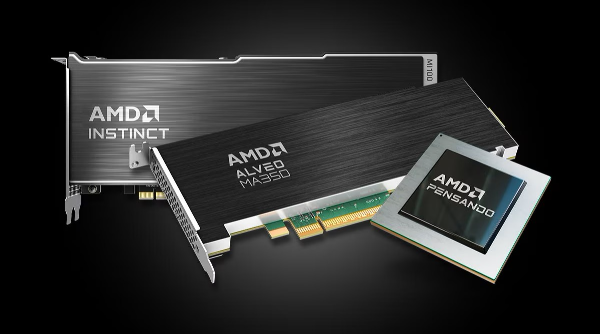AMD (Advanced Micro Devices) has been under immense pressure, shedding over 50% of its value in the last 12 months. Investors are left questioning whether the stock has finally found a bottom or if it is poised for further declines. MarketBeat analyst Thomas Hughes provides insights into AMD's recent price action and its future outlook.
Examining AMD's Price Action: A Tale of Two Bubbles
The AMD stock chart tells a story of two bubbles: the "COVID bubble" and the "AI bubble." The recent AI-driven surge in AMD's valuation was inspired by the booming growth of Nvidia and the data center business. However, AMD did not achieve the same success as Nvidia, leading to a market correction. Notably, AMD's price has fallen below analysts' lowest price target range, placing the stock in a critical support zone.
While technical analysis indicates a bottom may be forming, there is no definitive confirmation yet. However, the confluence of support levels suggests that a significant rebound could be on the horizon.
Analysts' Perspective: Price Targets and Long-Term Outlook
The decline in AMD’s stock since early 2024 can be largely attributed to downward price target revisions from analysts. This adjustment followed the realization that AMD’s data center business wouldn’t mirror Nvidia’s explosive growth. Despite this, analysts maintain a "Moderate Buy" rating for AMD and project upside potential. The consensus price target stands at over 50% higher than the current price, signaling optimism for a recovery.
Navigating Market Sentiment
One of AMD’s challenges is overcoming negative market sentiment. Many investors view the stock as a "falling knife," leading to hesitance in buying during declines. Nevertheless, AMD's long-term growth prospects remain strong. The company continues to see triple-digit growth in its data center segment and improvements in PC, client, and gaming segments. Furthermore, AMD is poised to benefit from a multi-year, multi-phase upgrade cycle encompassing AI, IoT, and personal computing.
The Bigger Picture: AI Growth and Industry Trends
The AI sector is still in its infancy, with significant growth opportunities ahead. While Nvidia has led the way, the broader AI ecosystem, including AMD, stands to benefit from increasing adoption and infrastructure development. As data centers come online and AI models mature, demand for powerful chips and advanced technologies will continue to rise.
Economic Headwinds: Tariffs and Supply Chains
Economic factors, such as potential tariffs on Taiwanese chips, pose a threat to AMD. However, tariffs are not a new challenge and have already accelerated efforts to onshore U.S. supply chains. AMD, like other chip design companies, relies on foundries like Taiwan Semiconductor, making it susceptible to geopolitical risks. Nevertheless, these issues are part of an ongoing narrative, and AMD has been proactive in adapting to the evolving landscape.
Institutional Activity: A Bullish Signal
Institutional investors have shown renewed interest in AMD, ramping up buying activity in 2024 and 2025. Buying volume currently outpaces selling volume by a ratio of 1.5-to-1, creating a strong tailwind for the stock.
Looking Ahead: Is a Rally Imminent?
The key to AMD’s recovery lies in greater clarity on tariffs and broader market conditions. Once uncertainties subside, AMD and the broader tech market could see a strong rebound. While volatility remains a challenge, the long-term growth trajectory for AMD and the AI sector is undeniably robust.
https://youtu.be/zhv6iHpMMZ0?si=ClAXUIyXFMVCMhS5






























AMD (Advanced Micro Devices) has been under immense pressure, shedding over 50% of its value in the last 12 months. Investors are left questioning whether the stock has finally found a bottom or if it is poised for further declines. MarketBeat analyst Thomas Hughes provides insights into AMD's recent price action and its future outlook.
Examining AMD's Price Action: A Tale of Two Bubbles
The AMD stock chart tells a story of two bubbles: the "COVID bubble" and the "AI bubble." The recent AI-driven surge in AMD's valuation was inspired by the booming growth of Nvidia and the data center business. However, AMD did not achieve the same success as Nvidia, leading to a market correction. Notably, AMD's price has fallen below analysts' lowest price target range, placing the stock in a critical support zone.
While technical analysis indicates a bottom may be forming, there is no definitive confirmation yet. However, the confluence of support levels suggests that a significant rebound could be on the horizon.
Analysts' Perspective: Price Targets and Long-Term Outlook
The decline in AMD’s stock since early 2024 can be largely attributed to downward price target revisions from analysts. This adjustment followed the realization that AMD’s data center business wouldn’t mirror Nvidia’s explosive growth. Despite this, analysts maintain a "Moderate Buy" rating for AMD and project upside potential. The consensus price target stands at over 50% higher than the current price, signaling optimism for a recovery.
Navigating Market Sentiment
One of AMD’s challenges is overcoming negative market sentiment. Many investors view the stock as a "falling knife," leading to hesitance in buying during declines. Nevertheless, AMD's long-term growth prospects remain strong. The company continues to see triple-digit growth in its data center segment and improvements in PC, client, and gaming segments. Furthermore, AMD is poised to benefit from a multi-year, multi-phase upgrade cycle encompassing AI, IoT, and personal computing.
The Bigger Picture: AI Growth and Industry Trends
The AI sector is still in its infancy, with significant growth opportunities ahead. While Nvidia has led the way, the broader AI ecosystem, including AMD, stands to benefit from increasing adoption and infrastructure development. As data centers come online and AI models mature, demand for powerful chips and advanced technologies will continue to rise.
Economic Headwinds: Tariffs and Supply Chains
Economic factors, such as potential tariffs on Taiwanese chips, pose a threat to AMD. However, tariffs are not a new challenge and have already accelerated efforts to onshore U.S. supply chains. AMD, like other chip design companies, relies on foundries like Taiwan Semiconductor, making it susceptible to geopolitical risks. Nevertheless, these issues are part of an ongoing narrative, and AMD has been proactive in adapting to the evolving landscape.
Institutional Activity: A Bullish Signal
Institutional investors have shown renewed interest in AMD, ramping up buying activity in 2024 and 2025. Buying volume currently outpaces selling volume by a ratio of 1.5-to-1, creating a strong tailwind for the stock.
Looking Ahead: Is a Rally Imminent?
The key to AMD’s recovery lies in greater clarity on tariffs and broader market conditions. Once uncertainties subside, AMD and the broader tech market could see a strong rebound. While volatility remains a challenge, the long-term growth trajectory for AMD and the AI sector is undeniably robust.
https://youtu.be/zhv6iHpMMZ0?si=ClAXUIyXFMVCMhS5